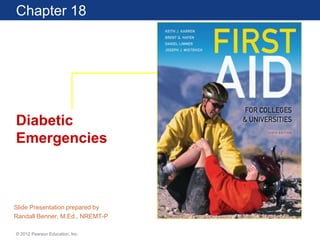More Related Content
Similar to Lecture 15_M18_KARR120_10E_PPT_C18.ppt (20)
Lecture 15_M18_KARR120_10E_PPT_C18.ppt
- 2. Learning Objectives
• Understand the basic disease process associated
with diabetes mellitus.
• Differentiate between hyperglycemia and
hypoglycemia.
• List the signs and symptoms of hyperglycemia.
• List the signs and symptoms of hypoglycemia.
• Describe and demonstrate the first aid care of a
severe hyperglycemic victim.
• Describe and demonstrate the first aid care of a
hypoglycemic victim.
© 2012 Pearson Education, Inc.
- 3. Introduction
• More than 14 million diabetics in the U.S.
• First indication of the disease often occurs when
a patient experiences their first diabetic
emergency
• First Aiders can provide better care when they
understand the underlying disease process and
management goals.
© 2012 Pearson Education, Inc.
- 4. Diabetes Overview
• Role of insulin in glucose transport into cell
– Glucose levels rise in the blood stream, causing
additional complications.
– Cells resort to using fat and proteins for glucose
creation.
– Without insulin, the glucose still cannot enter the cell.
© 2012 Pearson Education, Inc.
- 6. Types of Diabetes
• Type I (IDDM)
– Little or no insulin production
– Usually starts in childhood
• Type II (NIDDM)
– Insufficient secretion of insulin, or low sensitivity
of cells to insulin presence
– Formerly known as adult onset diabetes
• Gestational diabetes
– Occurs as a result of pregnancy
– Managed with diet, and occasionally, medications
© 2012 Pearson Education, Inc.
- 7. Hyperglycemia Characteristics
• Hyperglycemia (high levels of glucose)
– Glucose spills into urine, patient becomes dehydrated
and acidic
– Altered mental status, dehydration, poor vitals
– Fever, hyperventilation, abdominal pain
– Fruity odor on breath, air hunger
– Frequent urination, intense thirst
© 2012 Pearson Education, Inc.
- 9. Hypoglycemia Characteristics
• Hypoglycemia (low levels of glucose)
– Low glucose levels result in brain dysfunction and
changes in mental status
– Possibly combative, dizzy
– Rapid pulse and breathing, blood pressure usually
normal
– Seizures or tremors
– No thirst, no excessive urination
– Moist, pale skin, no fever
© 2012 Pearson Education, Inc.
- 11. Other Assessment Considerations
• Always assess for history of diabetes in
unresponsive patients.
– Medical Alert Tag
– Insulin injection marks on thigh or abdomen
– Insulin pump on the body
– Evidence of diabetic medicine near/on patient
• If in doubt, the careful administration of sugar to
the patient will not be harmful.
© 2012 Pearson Education, Inc.
- 13. First Aid: Hyperglycemic Victim
• Take standard precautions, activate EMS.
• Consider manual stabilization of cervical spine.
• Open and maintain the airway.
• Provide artificial ventilations if breathing is
inadequate.
• Be alert for vomiting, position patient on their side
if no trauma is suspected.
• Treat for shock, keep the patient warm.
• Reassess and reassure the victim until EMS
arrives.
© 2012 Pearson Education, Inc.
- 14. First Aid: Responsive Hypoglycemic Victim
• Take standard precautions, activate EMS.
• If patient can follow commands
– Administer orange juice with added sugar.
– Administer concentrated oral glucose if available.
• Do NOT give hard candy.
• Watch for vomiting, position patient on side.
• Treat for shock, keep the patient warm.
• Reassure and monitor the victim until EMS
arrives.
© 2012 Pearson Education, Inc.
- 15. First Aid: Unresponsive Hypoglycemic
Victim
• Take standard precautions, activate EMS.
• Consider manual stabilization of cervical spine.
• Open and maintain the airway.
• Provide artificial ventilations, if necessary.
• Watch for vomiting.
• Position patient on their side if no trauma is
suspected.
• Treat for shock, keep the patient warm.
• Monitor continuously until EMS arrives.
© 2012 Pearson Education, Inc.
- 16. Summary
• Diabetes is a common disease in the U.S.
population.
• The disease occurs when the body produces too
little insulin or cannot effectively use the insulin it
produces.
• Hyper- and Hypo- glycemia are the two
conditions that arise from diabetic complications.
• Untreated diabetes, hyperglycemia, and
hypoglycemia are serious conditions requiring
medical intervention.
© 2012 Pearson Education, Inc.
